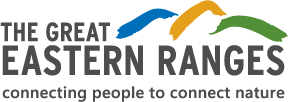
The sheer magnitude and intensity of bushfire crisis that has beset entire regions of the GER corridor necessitate coordinated and complementary efforts to restore habitat and assist wildlife across eastern Australia. To ensure a coordinated and complementary response to the devastating black summer bushfires, GER has released a phased bushfire recovery plan.
The Great Eastern Ranges Initiative (GER) is in a unique position to be able to respond to the fires through a staged approach that reacts quickly to the immediate threat, whilst ensuring the long-term restoration, resilience and connectivity of our land, wildlife and communities post-fire.
Since 2007, GER has been bringing people and organisations together to find innovative solutions that address environmental challenges just like these, stemming the loss of native species, providing natural solutions to climate change, protecting precious resources and ensuring a healthy, resilient landscape for wildlife and people.
Our well-established network of regionally based partnerships, involving more than 250 organisations, collaborate on locally led projects and initiatives across 11 key landscapes spanning the length of Australia’s Great Eastern Ranges. GER provides the common vision, science, geographic focus and shared priorities that bring people together to achieve results that are far greater than the sum of their parts.
We know where habitat needs to be urgently restored in response to the fires and where unburnt habitat can be enhanced to help sustain wildlife. We already have the people and structures in place to enable us to coordinate complementary restoration efforts across organisations, land tenures and regions in a way that has a much greater impact at the continental scale.
A phased approach to help restore and reconnect nature:
Phase 1 – Emergency relief:
The first phase of recovery will involve the immediate support of wildlife carer groups who are working to keep animals and birds impacted by the fires alive. People are being increasingly coordinated through WIRES and other local care groups to put food and water out in unburnt areas and immediately adjacent to burn scars, whilst others are focused on search for and recovery of animals. To support these efforts, we will work with the Land For Wildlife and Landcare networks to distribute information to landholders about practical things they can do to help and point them towards local experts who can provide advice.
Phase 2 – Restoration and recovery:
We are already rapidly gearing up to follow with a second phase of recovery and restoration that involves three different types of project:
- Restoration of feed areas: Co-ordinated replanting of key feed areas with high nectar-producing shrubs and trees to support nomadic species such as flying foxes and honeyeaters, who will increasingly rely on these landscapes for survival in the next few years.
- Creation of habitat: The establishment of supplementary habitat for small, tree-dependent mammals such as gliding possums, phascogales and microbats through the installation of nest boxes to replace lost natural tree hollows. Projects will also include restoration of native understorey to increase insect prey numbers and improve general habitat structure, as well as strategic management of feral predators.
- Facilitating wildlife movement: The creation and enhancement of climate change corridors to enable movement, adaptation and recovery of koalas and other mobile, forest-dependent native species that need to disperse and recolonise habitat patches as they recover.
Phase 3 – Building long-term resilience:
The third phase of long-term recovery efforts will focus on strengthening and consolidating the health and value of habitat in unburnt regions and help to protect them from future fire events. Despite the enormity of the losses, substantial parts of the ranges remain unburnt and will be critical to the survival of a host of birds, mammals, reptiles and insects that have been pushed close to the edge of extinction through loss of core populations. In the case of areas that have been intensely devastated by the fires, we will work to re-age and re-wild these in the future to increase the diversity of plant species and support a greater range of wildlife.
Click here to view our comprehensive bushfire recovery plan.



 Article
Article